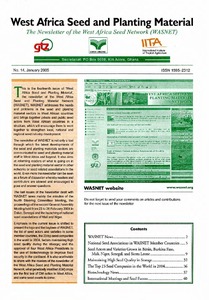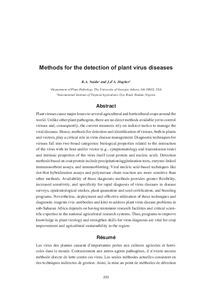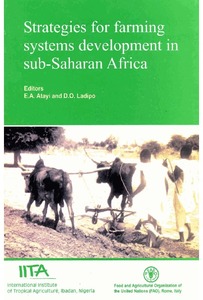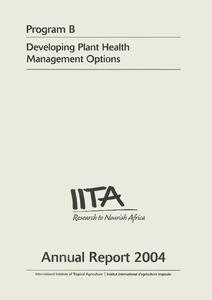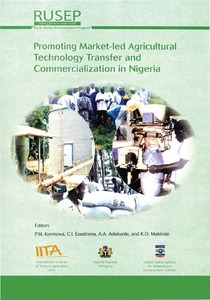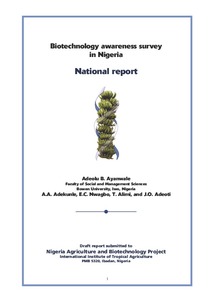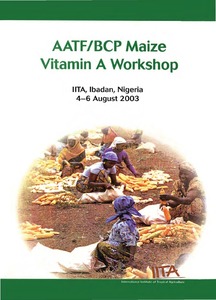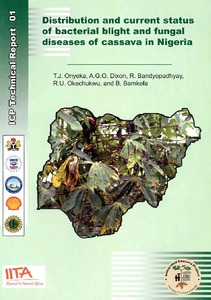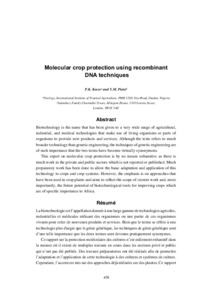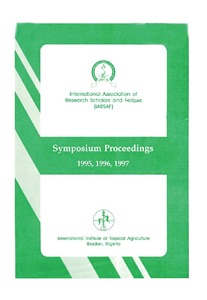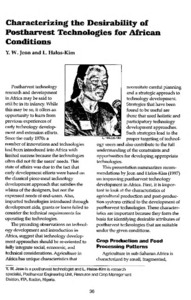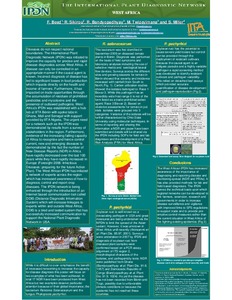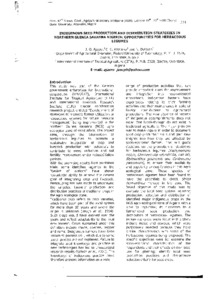Welcome to the International Institute of Tropical Agriculture Research Repository
Conference Documents: Recent submissions
Now showing items 441-460 of 597
-
Association between zigzag stem habit and resistance/tolerance to cassava brown streak virus disease
(2004)Cassava is an important food staple in the coastal provinces of east and southern Africa. However, its production is adversely affected by cassava brown streak virus disease (CBSD). CBSD first reported from Amani, Tanzania in 1936, is now considered to be one of the major biotic constraints to cassava production especially in the coastal lowlands. Efforts to develop resistant varieties as the major control measure for CBSD started way back in the 1940s. in efforts to improve breeding efficiency, ... -
Prospects for breeding agronomically superior Musa with resistance or tolerance to BSV
(2003)The genetic improvement of banana and plantain has focused on breeding for resistance to black sigatoka. This has been quite successful, but the distribution of improved hybrids has been impeded by the outbvreak of Banana streak virus (BSV). Integration of viral sequences in Musa genomes make it difficult to apply commonly accepted principles for host-plant resistance. The short-term strategy of breeding programs at IITA was to address the BSV issue through a practical approach based on identification ... -
Economic losses experienced by smallscale farmers in Malawi due to cassava brown streak virus disease
(2003)Cassava is an important root crop in Malawi. It is the second most important food crop after maize. It is grown throughout the country as a food security crop, sack/cash crop, and as a staple food crop along the Lake Malawi. Is is a staple for over 39 % of the country’s population. Farmers are not benefiting as much as they might from cassava because they are faced with a number of constraints. These include: - inherent low yielding and late maturing local cultivars - pests and diseases ... -
Methods for the detection of plant viruse diseases
(2003)Plant viruses cause major losses to several agricultural and horticultural crops around the world. Unlike other plant pathogens, there are no direct methods available yet to control viruses and, consequently, the current measures rely on indirect tactics to manage the viral diseases. Hence, methods for detection and identifi cation of viruses, both in plants and vectors, play a critical role in virus disease management. Diagnostic techniques for viruses fall into two broad categories: biological ... -
Overview of viruses of legumes other than groundnut in Africa
(2003)Many legume species are grown in sub-Saharan Africa (SSA). In addition to groundnut (Arachis hypogaea L.), which has a major production area in West Africa, Cicer arietinum L. (chickpea), Glycine max (L.) Merr. (soybean), Vigna unguiculata (L.) Walp. (cowpea), Phaseolus spp. (bean), and Cajanus cajan (L.) Millsp. (pigeon pea) are widely grown in sub-Saharan Africa (Allen and Lenné 1998). The yield of these crops from sub-Saharan Africa in 2001 is given in Table 1 and, while it reflects the relative ... -
Cassava mosaic disease and its causal agents: the Nigeria situation
(2003)Highlights are presented on the status of knowledge about cassava mosaic disease (CMD) and its causal agents in Nigeria. The disease occurs in all the agroecologies where cassava is grown, from the humid forest in the south to the semiarid and arid agroecologies in the north. The severity is generally moderate but can be very severe on susceptible genotypes. A severe outbreak of the disease was recorded in the late 1980s in Akwa Ibom State in southeastern Nigeria and was curtailed through the use ... -
Cassava virus diseases in Africa
(2003)Cassava plays a key role in the food security of sub-Saharan Africa, but as a vegetatively propagated crop, it is particularly vulnerable to the effects of virus diseases and these therefore represent a major threat to the livelihoods of millions of Africans. Nine viruses have been isolated from African cassava, but only cassava mosaic geminiviruses (CMGs) and Cassava brown streak virus (CBSV) cause diseases of major economic signifi cance. In recent years, both CMGs and CBSV have come under ... -
An overview of viruses infecting Dioscorea yams in subSaharan Africa
(2003)Viruses of the genera Potyvirus, Potexvirus, Badnavirus, Cucumovirus, and Carlavirus infect yams of different species worldwide. These viruses cause a range of symptoms including mosaics, mottle, vein clearing, chlorosis, stunting, and distortion. These lead to a chronic and sometimes severe disease situation in all yam growing areas. In sub-Saharan Africa, where more than 90% of the world’s yams are produced, Yam mosaic virus (YMV), genus Potyvirus is an ubiquitous pathogen. It is the only ... -
Development and regional deployment of streak virus resistant maize germplasm: an overview
(2003)The Maize streak virus (MSV) disease has been one of the most devastating diseases of maize (Zea mays L.) in all the countries of West and Central Africa (WCA). For a long time, breeding for resistance to the disease was frustrating because of lack of facilities for uniform artifi cial inoculation. In 1975, a collaborative project involving the International Institute of Tropical Agriculture (IITA), the International Maize and Wheat Improvement Center (CIMMYT), and the national agricultural research ... -
Yam breeding
(2003)Yams (Dioscorea species of family Dioscoreaceae) are important for food, income, and sociocultural activities especially in West and Central Africa and account for about 93% of the world’s annual production of 38 million tonnes. Breeding of yams is focused primarily on the two dominant species, D. rotundata Poir. and D. alata L., and it is carried out within the context of improving yam-based systems. Constraints to productivity of cultivation and opportunities for improvement are identifi ed ... -
Molecular crop protection using recombinant DNA techniques
(2003)Biotechnology is the name that has been given to a very wide range of agricultural, industrial, and medical technologies that make use of living organisms or parts of organisms to provide new products and services. Although the term refers to much broader technology than genetic engineering, the techniques of genetic engineering are of such importance that the two terms have become virtually synonymous. This report on molecular crop protection is by no means exhaustive as there is much work in the ... -
Mapping and monitoring agricultural land use in West Africa
(2008)West Africa has experienced increases in cultivated lands over the last 50 years in order to meet increasing demand from rapidly growing populations. Most countries in the region still depend on agriculture as an important part of the economy. In most countries however agricultural productivity is low leading to food insecurity and poor performance of the whole sector. In the Maputo declaration of 2004 the African governments committed to spending at least 10% of the national budget resources on ... -
Cassava improvement in sub-Saharan Africa: contributions of IITA and its partners
(2008)Cassava is well recognized for its capacity to address food needs of vulnerable communities in unstable environments in SSA. IITA and colleagues in African NARS, in collaboration with CIAT and ARIs have played leading roles in the development of improved cassava varieties which are disease and pest resistant, early maturing, and high yielding. Through a combination of conventional and new approaches, over 400 cassava genotypes have been developed. The characteristics of the new generation of cassava ... -
The International Plant Diagnostic Network West Africa
(2008)Diseases do not respect national boundaries. The International Plant Diagnostic Network (IPDN) was initiated to improve the capacity for precise and rapid disease diagnostics across West Africa. A disease can only be controlled in an appropriate manner if the causal agent is known. Incorrect diagnosis of disease has led to significant losses in food production which impacts directly on the health and income of farmers. Furthermore, it has impacted on trade opportunities through the accumulation ... -
Ploidy versus gender effects on inheritance of quantitative traits in Musa species
(2008)Several factors including ploidy and genome composition influence the inheritance of agronomic traits in Musa populations. Research results have indicated that gender determines the inheritance of quantitative traits in this species, but whether inheritance patterns are ploidy-dependent or gender-dependent is not known. The present research is therefore aimed at evaluating the agronomic performance of progenies of 4x - 2x versus 2x - 4x crosses in Musa, in other to understand how gender or ploidy ...

